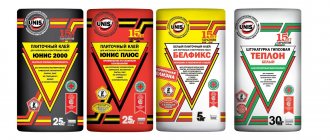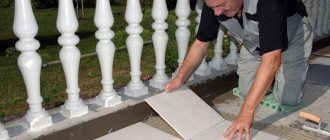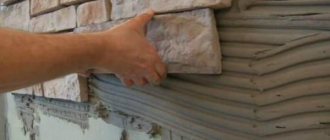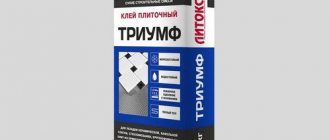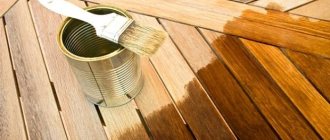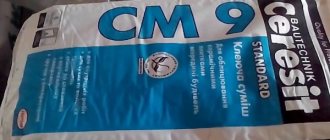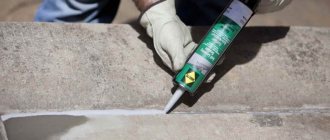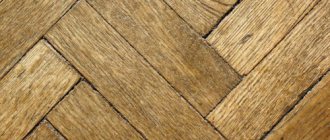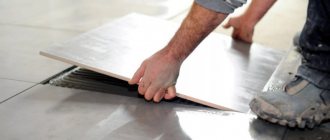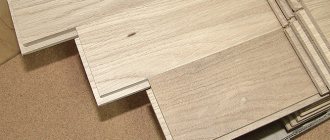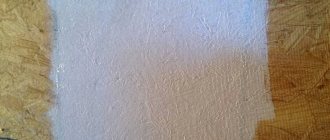The wrong choice of adhesive mixture for facade mesh leads to peeling of the coating, the appearance of cracks, and the need for frequent repairs to the cladding. Quality, strength and durability depend on the chosen composition. The adhesive for facade tiles also acts as plaster.
Using a high-quality composition, you can seal holes, cracks, and crevices. In addition, high-quality glue blocks cold bridges, eliminating freezing through the seams indoors. The packaging of the adhesive mixture for facade plaster contains the MPZ marking, which confirms frost resistance and the ability to operate at temperatures down to -15 degrees.
R-25 Adhesive for laying tiles “Professional” 5kg
Purpose
for interior and exterior work
Laying
“tile on tile”
Feature
for the “Warm Floor” system
Adhesion
1.2 MPa
Contains
polymer additives
Type
moisture-resistant, frost-resistant
Price from 80 rub.
More details
R-67 MRZ Adhesive for laying blocks of cellular and foam concrete MRZ (winter) 25 kg
Purpose
for external and internal work
Thin joint
1 - 5 mm
3 in 1
laying, plastering and repairing blocks
Price from 177 rub.
More details
R-25 Tile adhesive “Professional” (class C1)
Purpose
for interior and exterior work
Laying
“tile on tile”
Feature
for the “Warm Floor” system
Adhesion
1.2 MPa
Contains
polymer additives
Type
moisture-resistant, frost-resistant
Price from 241 rub.
More details
R-28 Pool glue
Purpose
for interior and exterior work highly elastic, resistant to deformation
High
adhesion Type
moisture-resistant, frost-resistant
Feature
resistant to tiles sliding
Application
on plasterboard and chipboard, for swimming pools, for heated screeds, for laying large-format tiles
from 410 rub.
More details
R-29 Adhesive for porcelain tiles with high fixation (class C2)
Purpose
for interior and exterior work
Enhanced adhesion to a surface of
1.6 MPa
Increased
resistance to slipping Use
of heavy slabs on the plinth and facade, porcelain tiles on “Warm floors”
Thickness of the adhesive layer
2 – 6 mm
Type
moisture-resistant, frost-resistant, highly plastic
from 318 rub.
More details
R-29 Adhesive for laying porcelain tiles (white)
Purpose
for interior and exterior work
Enhanced adhesion to a surface of
1.6 MPa
Increased
resistance to slipping Use
of heavy slabs on the plinth and facade, porcelain tiles on “Warm floors”
Thickness of the adhesive layer
2 – 6 mm
Type
moisture-resistant, frost-resistant, highly plastic
from 364 rub.
More details
R-62 Adhesive for gluing expanded polystyrene boards 25 kg
Purpose
for external and internal work
Features
on heated surfaces (up to +100ºС)
Application layer thickness mm
up to 2-20 mm
Adhesion
up to 1.44 MPa
Type
waterproof, frost-resistant, high-adhesive
Price from 261 rub.
More details
R-67 MRZ Adhesive for laying blocks of cellular and foam concrete MRZ (winter) 40 kg
Purpose
for external and internal work
Thin joint
1 - 5 mm
3 in 1
laying, plastering and repairing blocks
Price from 259 rub.
More details
R-67 Adhesive for laying blocks of cellular and foam concrete 25 kg
Purpose
for external and internal work
Thin joint
1 - 5 mm
3 in 1
laying, plastering and repairing blocks
Price from 162 rub.
More details
R-67 Adhesive for laying blocks of cellular and foam concrete 40 kg
Purpose
for external and internal work
Thin joint
1 - 5 mm
3 in 1
laying, plastering and repairing blocks
Price from 234 rub.
More details
Peculiarities
When it comes to laying tiles outdoors, there is a need to use a special adhesive. Various requirements may be placed on it, which is determined by the peculiarities of the facing work and the conditions in which the object will be operated. But one thing remains unchanged: the glue must be frost-resistant. This requirement is dictated by the characteristics of the region in which we live. For all exterior work that requires the use of tile adhesive, a frost-resistant mixture is required.
This feature is achieved by adding additives to the composition. These components do not allow water molecules to expand under negative temperature conditions. With regular adhesive, water expands as it freezes, causing the coating to peel off, causing the tiles to come loose or develop cracks on the surface.
In addition to frost resistance, a number of requirements are imposed on the tile adhesive that is selected for exterior work:
- high strength indicators;
- high ability to adhere to various surfaces;
- resistance to deformation caused by exposure to negative temperatures.
Mechanical stability and substance consumption
On store shelves, frost-resistant adhesive mixtures for porcelain tiles can be found in standard volumes. It is sold in bags of 25 kg. Consumption for each brand and type of glue will be determined individually. On average, this is 25 kg per 1 m². Porcelain tiles, due to the characteristics of the material, are quite heavy, so the selected frost-resistant adhesive must have a high degree of adhesion and compressive strength.
When laying tiles, the thickness of the adhesive layer should be 2-5 mm. This indicator is also determined depending on the characteristics of the tile itself, including its thickness and format. Significant consumption of frost-resistant adhesive is provided if it is necessary to equip a heated floor system, since the thickness of the adhesive layer under the tile increases.
An ordinary spatula is not suitable for applying frost-resistant tile adhesive, as the result will be poor-quality installation of porcelain tiles and a decrease in the service life of the cladding. To work, you need to choose a comb spatula of a size corresponding to the thickness of the glue layer. The corresponding numbers are indicated on the packaging with the tools, but most often this is a direct proportional relationship. The thicker the mixture layer, the higher the tool number and vice versa.
Advice! In order to level the surface for laying tiles, you should not use frost-resistant adhesive for porcelain tiles. For these purposes, you need to select special mixtures and apply them one step earlier.
Choosing the Right Tile Adhesive
Successful gluing and durability of tile adhesive depend on many factors. The adhesive for exterior tiles must always be chosen correctly so that the cladding adheres well, does not crack or discolor, and can be pleasing to the eye for years.
What to consider when choosing tile adhesive:
- The type of base on which the tiles will be glued;
- There may be unevenness of the walls and floor, for example, bulges, deviations from the vertical or horizontal. If they are large, the layer of mortar on which the tiles will be laid will have different thicknesses - large in one place, small in another - and then it is necessary to use mortar with the corresponding recommended maximum and minimum thickness;
- The type of cladding on which their water absorption depends;
- Tile sizes;
- Where the liner will be installed: around a pool or on a heated base, for example, adhesives must be used to allow the base to expand or contract with the adhesive underneath the tiles due to temperature changes;
Time taken to lay tiles: Sometimes it is very important that the room in which they are laid can be used in the shortest possible time. In this case, you should use quick-setting glue.
Cement glaze adhesives are a dry mixture of gray or white cement, carefully selected mineral fillers, polymers and modifiers. In order for the dry solution to be ready for use, it must be mixed in the appropriate proportion with water.
Suitable conditions for working with glue
When choosing tile adhesive for the street, you need to consider the following basic parameters:
- The shelf life of the composition, how long it retains its properties after mixing. On average, for adhesives the indicator varies from 1 to 8 hours.
- The time for the glue to completely dry or harden is the average of 24 hours for most manufacturers.
- Curing time, that is, the permissible period during which the position of the tile or other incorrectly fixed cladding elements can be corrected. Duration on average from 15 to 30 minutes.
- Ambient temperature. During repair work at air temperatures above 15°C, you need to choose a type of glue that will dry longer, so that you can make adjustments to the work. If the air temperature is less than 15°C, then you need to choose a mixture with the maximum hardening speed.
Properties of the adhesive composition
Dry mixtures are sometimes used for plastering. The reason for this is a number of properties:
- high adhesiveness;
- plastic;
- resistance to environmental conditions (temperature, humidity);
- quick drying of the mixture (important for situational rather than planned repair work).
The parameters of universal and specialized compositions are, in most respects, higher than those of profile mixtures for plaster. If you have a tight time frame for wall finishing, this is an indispensable option.
Kinds
Fast-curing glue
A special feature of this glue is the minimum working life of the finished solution. Final hardening occurs after 3 hours, while other compositions set no earlier than after 24 hours. In this case, the surface can be used almost immediately after finishing. However, using quick-hardening glue to work with large areas is inconvenient, since the prepared solution must be used up within 30 minutes. Such compositions are excellent for cladding walls indoors, in particular when arranging a kitchen apron, but can also be used during certain types of outdoor work.
Leveling glue
To eliminate large unevenness in the base, plaster or screed is usually used. However, minor bulges and depressions will not become a hindrance in the finishing process if you know exactly which tile adhesive for porcelain tiles is best to choose in such a case. Leveling adhesives are used both for cladding indoor surfaces and for laying façade coverings. When arranging balconies, attics, terraces or basements, such glue often allows you to do without pre-treatment of the base.
Heat resistant glue
In this case, the name of the composition speaks for itself. The ability of a heat-resistant adhesive to withstand elevated temperatures makes it possible to use it when facing very hot surfaces. To understand which adhesive to choose for porcelain tiles, it is necessary to determine the maximum temperature level that the base reaches. The most resistant to thermal effects is the mixture intended for finishing fireplaces and stoves. It is designed for temperatures within 600°C. In addition, there is a heat-resistant adhesive for porcelain tiles.
Thick layer adhesive
For interior finishing work, cladding material is often selected in the form of large-format products, which are usually used to create floor coverings. In this case, the expected thickness of the layer of the adhesive composition used should be at least 10-12 mm. It should be taken into account that certain types of mixtures are intended for external use.
Frost-resistant glue
For tiles used in low ambient temperatures, a special mixture is used, including one that is not destroyed by moisture. It is mainly used for finishing the surfaces of balconies, terraces, and plinths. In addition, such mixtures have proven themselves to be reliable fixatives for polystyrene foam, mineral wool and other insulation materials.
Universal formulations
Today on sale you can find tile adhesives designed for different types of facing materials, including porcelain stoneware. In this case, it is assumed that the mixture will be used both for finishing indoor surfaces and for some outdoor work. Such compositions are suitable for most products with standard sizes. The only exception is their use when laying large-format tiles.
Areas of application of various adhesive compositions for porcelain tiles
| Fast-hardening | Leveling | Elastic | Heat resistant | Thick layer | Reinforced fixation | Frost-resistant | Universal | |
| External use | ||||||||
| Porch | ||||||||
| Balcony, terrace | ||||||||
| Parapets, stairs | ||||||||
| Base | ||||||||
| Internal use | ||||||||
| Walls | ||||||||
| Floor | ||||||||
| Heating floor | ||||||||
| Bath, toilet | ||||||||
| Kitchen apron | ||||||||
| Pool | ||||||||
| Stoves, fireplaces | ||||||||
| Allowed types of bases | ||||||||
| Concrete | ||||||||
| Lightweight concrete | ||||||||
| Cellular concrete and cinder concrete | ||||||||
| Heated screed | ||||||||
| Plaster, putty | ||||||||
| Drywall, OSB | ||||||||
| Tree | ||||||||
| Plywood | ||||||||
Types of glue
Moisture-resistant and frost-resistant adhesive for street tiles comes in the following types:
- Universal glue. Designed to perform standard functions: to be the basis for laying small and medium-sized slabs outdoors, as well as on various other surfaces. This outdoor, frost-resistant glue is preferred by novice craftsmen who are not interested in technological nuances. However, this variety should not be used in cases where a significant decrease in air temperature is possible.
- Reinforced glue. It is used to lay tiles on the street, as well as outside buildings measuring from 30*30 cm. Unlike the universal one, which is more suitable for laying tiles on walls, the reinforced version ensures good adhesion during floor laying, both inside and outside. as well as outside. The glue also reacts poorly to temperature changes, but it is not afraid of static and dynamic loads.
- Moisture-resistant adhesive for lining swimming pools. Standard types of glue are not able to withstand prolonged exposure to moisture. If it is water in its pure form, then the substances will rapidly lose their properties. Therefore, special compositions are produced for lining pools that do not deform, do not collapse under the influence of moisture, and do not peel off porcelain tiles in water conditions. But such cool compounds are not suitable for outdoor use.
- Heat resistant adhesive. It is considered the opposite of frost-resistant and is used for cladding porcelain stoneware or other tiles, artificial stone for stoves, fireplaces, heated floors and other areas where exposure to high temperatures is present.
- For non-standard surfaces - a special facade frost-resistant adhesive, which allows you to comfortably work with such bases as metal, wood, plastic and others.
- White glue is a special composition for decoration, most often used for cladding with transparent mosaics.
- Frost-resistant adhesive – this outdoor adhesive can work in any conditions where there is no constant heating. This adhesive is highly resistant to temperature changes and contains special substances that increase the elasticity of the adhesive composition, as well as its adhesion primarily to ceramics, porcelain tiles and the base. During operation, the glue does not deform. Temperature limits may vary from manufacturer to manufacturer.
On video: Tile adhesive for porcelain tiles.
Rules for using frost-resistant adhesives
The use of frost-resistant adhesives does not cause any particular difficulties for craftsmen. Typically, the manufacturer indicates on the packaging all the necessary details and operating conditions, and offers detailed instructions. The glue must be diluted according to the instructions. Glue is applied to the base with a special notched trowel.
You must first prepare the surface for applying glue. It should be cleaned, degreased, and treated with a primer to evenly distribute the composition and eliminate problems when laying tiles. The thickness of the layer must be selected depending on the characteristics of the product, as well as the finishing material. There are solutions that only need to be applied in a thin layer. This ensures economical consumption and at the same time reliable fastening.
Plastering walls with adhesive mixture
The use of an adhesive mixture as plaster requires careful technical preparation and compliance with work standards. Let's take a step-by-step look at how to prepare a wall for plastering.
Preparing the base
The surface on which the adhesive mixture will be applied must be cleaned of unstable pieces, large debris, grease, and biological substances.
Removal of traces of fat occurs with a sponge soaked in a soap solution.
In places with high humidity, treatment with antifungal compounds is carried out. A mandatory item in any room is to apply a primer to the cleaned surface (durable adhesion of the plaster to the wall).
Installation of beacons
When working on an entire plane, be sure to place beacons. Their function is to prevent unevenness. Depending on the surface on which the plaster is applied, the step between them varies in the range of 0.4-0.6 m.
When working with glue, it is better to make beacons in small increments, since the mixture is quite dense, it is difficult to level a large area at once.
A special profile is attached to self-tapping screws, or a small amount of plaster itself. Mounting is carried out according to the level, and before final fastening everything is checked again with the device.
Preparation of the solution
When working with adhesive dry mixture, you must always have sand and water on hand. When mixing the components with a mixer, watch for “stickiness”. If the tools are difficult to pull out, they are all in the solution, then add sand.
It is better to dilute mixtures with glue by adding them to water, and not vice versa (adjusting the consistency).
A high-quality solution is always prepared in small portions, no more than 5 kg of glue. The reason is simple: the longer the contact with air, the less pronounced the gluing capabilities become. A realistic assessment of your strength when mixing the composition will prevent the glue from peeling off the wall.
Applying the composition to the wall
You can begin work after completing all preparatory stages. To apply and level the composition you will need a trowel and a rule.
- The first layer is applied with a thickness of no more than 0.4-0.6 mm. The consistency of the diluted glue resembles thin sour cream.
- It is better not to try to repair irregularities that are visible to the naked eye with the first layer. Too much mixture will lead to drying out with cracks and a separate piece falling off.
- The second, even thinner layer is applied a day after the first. It is desirable, but not essential, to treat the dry ball with a primer, then the second one will form a more reliable layer.
- The rule is to level the second layer. They pull it from the bottom up, guided by the placed beacons.
- The corners are leveled with a special spatula.
- Grouting is carried out after 12-24 hours. Depends on how quickly the composition dries.
The technology for applying tile adhesive as plaster is simple and does not differ from the use of plaster mixtures. Unless the layer should be thin, and the mass should be prepared in small portions.
For exterior decoration
If it is necessary to carry out cladding work on the outside of the building, glue for exterior finishing is used. This adhesive composition is characterized by high resistance to aggressive environments. The products do not change their appearance in the presence of temperature fluctuations or increased humidity levels.
Some specimens are able to remain in their original form even in strong winds and excessive ultraviolet radiation.
Many options are highly resistant to mechanical damage, which ensures safety and security for the internal layers of finishing.
You should pay attention to types of glue that guarantee excellent adhesion to the surface and high resistance to aggressive environmental factors.
If you decide to tile the porch, you need to make sure that the glue has water-repellent properties. When using glue for the base, enhanced fixation will be required , as well as the ability to repel moisture.
In some cases, glue is used to lay paving slabs. There is no adhesive for laying paving slabs, however, when deciding to lay masonry on a concrete surface, use almost any adhesive intended for outdoor work.
Typically, frost-resistant glue is used if it is necessary to finish a balcony, loggia, or glazed veranda.
Even if the listed premises are fully heated, the temperature in them is much lower than in the internal segments of the building. You should choose an adhesive that not only has high frost resistance, but also perfectly repels moisture. A feature of frost-resistant glue is its drying time and consumption.
Review of manufacturers
Most craftsmen use the same adhesive for paving slabs in their professional activities. But some still find it difficult to decide on the manufacturer of frost-resistant adhesive mixtures for tiles, since there are a huge number of them on modern markets.
It is worth considering the most popular manufacturers and their types:
- Ceresit CM 17. Is very popular due to its high degree of elasticity. This adhesive composition is not afraid of frost and moisture; it is able to maintain its properties under temperature changes from -50 to +80 °C. In many cases, Ceresit adhesive is the best frost-resistant choice for gluing tiles to a concrete base.
2. Unis 2000. No less popular among consumers, it is a good frost-resistant option, withstands up to -60 °C, as well as very high temperatures up to + 60 degrees. The glue is characterized by a fairly fast hardening speed, so the time to adjust the position of the material will be only 10-15 minutes.
3. Ceresit CM 117. It is characterized by high strength and reliability. It is chosen by customers for gluing heavy, very durable materials and substrates. These are stone slabs, concrete surfaces. The CM 117 variety has a good level of moisture resistance, so it is used for cladding street facades and creating flooring, as well as for finishing baths, swimming pools and saunas.
4. Ceresit CM 9. Can be used for external and internal work. It has a good level of moisture resistance, but can withstand temperatures of at least 15 degrees. If the operating conditions are not met, this will contribute to a reduction in service life, as well as rapid destruction.
5. Knauf Flex is a German brand that has also successfully gained customer recognition. The properties of frost-resistant adhesive allow it to be used for ideal laying of ceramic tiles. It has good heat resistance and moisture resistance. Operating temperature from -50…+ 50 °C. Knauf elastic tile adhesive will stick best to a concrete base. Therefore, you need to choose it for these types of work.
6. Knauf Fliesen. It is considered a universal German frost-resistant adhesive that is suitable for outdoor and indoor use. This is exactly the substance that the manufacturer recommends to apply in a thin layer, regardless of the thickness of the material used. The mixture has a good level of frost resistance, but not an important quality of moisture resistance, compared to other varieties. It is best to work with this adhesive on ceramic tiles with water-absorbing properties.
7. Kreisel Schnell-Fix106 is one of the fastest-drying types of glue, which is not afraid of sudden changes in temperature conditions. She feels comfortable on surfaces with excess moisture. This glue has excellent adhesion and wear on concrete, cement-concrete and cement-lime bases. But this mixture is completely unsuitable for working with porcelain stoneware when laying a heated floor system.
8. Ivsil Classic – this brand is best for gluing porcelain tiles to external concrete bases. It is characterized by high strength and the ability to withstand significant mechanical loads without subsequent destruction. It can also be used to install a heated floor system.
For interior decoration
Frost-resistant tile adhesive can be used not only on the outside of the building, but also on its interior. This need manifests itself if the room is not heated in sufficient quantities, and there is a risk of drafts.
Sometimes general operating features allow you to choose options that are less resistant to aggressive influences. Often they choose universal glue, which has a lot of useful properties.
As a result, it is possible to eliminate the risk of the formation of fungus, mold, and other problems that may appear in an unheated but stuffy room.
How to choose frost-resistant tile adhesive
The main thing that frost-resistant tile adhesive should be able to do is to withstand high levels of humidity and sudden changes in temperature. Only with such skills will he be able to firmly hold the tile in its place at any time of the year.
What do these properties depend on? They mainly depend on additives. The higher the quality of the additive, the better the properties of the frost-resistant tile adhesive. A good glue should also contain at least 40% mineral components.
Professionals in the field of construction and finishing advise purchasing mixtures that require only water. If any additives are required for breeding, then the beginner will not be able to cope on his own, or the result will not please him.
But there are also properties that are a bonus in favor of choosing such mixtures:
- Soundproofing;
- Complete drying speed;
- Self-compensating adhesive for unevenness;
- Absorption of stress between building layers;
- Protection from moisture without additional compounds.
When purchasing a mixture, carefully inspect it for the presence of impurities or heterogeneity. The mixture should be a homogeneous powder of one specific color.
Even if you have already worked with tile adhesive, still study the instructions included with the mixture. First of all, you need to pay attention to what surfaces the glue is suitable for. Prohibitions, exceptions and precautions are also indicated there.
Compound
There are several composition options and components that manufacturers use to make tile adhesive. Based on specific properties and characteristics, features of specific components, you can choose the best option for yourself.
Cement based
Supplied in dry configuration. In most cases, it has a fairly large proportion of cement, which is half or more when compared with other components. Sand and various additives are also used to ensure high strength and water-repellent properties.
This glue is universal and has a moderate cost.
It is advisable to use it only for finishing the interior of the room, since a large amount of cement can negatively affect the deterioration of water-repellent properties.
If you use glue that contains a large amount of cement, working with it is quite easy. Even an inexperienced craftsman can use such a cement composition to apply tiles.
In some cases, it is not possible to achieve sufficient moisture resistance, but a solution made using cement provides high reliability of fixation.
It is often used for leveling, which allows the tiles to be laid as aesthetically as possible.
Dispersive
Manufactured in paste configuration. It can be prepared in record time. During its application and operation, a large amount of dust is not generated. This type of frost-resistant adhesive is created with a standard composition that does not change depending on the specific manufacturer.
To use up this glue, you can allocate no more than 40 minutes. Often this time is enough to cover a large distance with tiles.
The adhesive contains various organic and mineral fillers, as well as additives that increase adhesive strength and impart other positive properties.
Dispersion adhesive is used for installation of almost any ceramic products: mosaic, natural stone, majolica, glazed and clinker tiles. Can be used both on a flat surface and on embossed bases.
Guarantees reliable fixation of tiles even on old tiles. Used for mounting finishing elements on a prepared base, with the exception of varnished surfaces.
Polyurethane
Created using just one component. Among its main qualities is increased elasticity, which ensures the strength of the base. Using this glue, you can ensure the durability of the structure due to the tight fit of the component parts.
Typically, polyurethane adhesive is used when it is necessary to cover a surface with a complex, unusual shape.
If you use glue correctly, you can avoid many difficulties and get the job done quickly and efficiently.
Epoxy
Manufactured on the basis of epoxy resin. There are the following types of this glue:
- with a fluid consistency.
- with filler , ensuring the formation of a thin layer during application;
- with an admixture of minerals.
Epoxy adhesive is available in the form of a homogeneous mixture. It is universal, as it can be used on almost any surface. It is often used for fastening finishing parts of swimming pools, bathrooms, and laundries, as it is characterized by water resistance.
Types of frost-resistant tile adhesive
It would seem that there may be differences between adhesive bases for attaching street tiles, but they differ in composition, which changes their additional properties.
There are several types of mixture:
- Cement base. This glue is the most common. Budget-friendly and recognized by all construction and finishing specialists.
- Immediately ready for use. Suitable for any surface and have excellent bonding properties.
- Based on polyurethane. They have high elasticity rates. That is why they are considered an ideal option for complex structures with irregular geometry.
- Based on epoxy resins. Most often they are composite, i.e. To work, you need to add a hardener in addition to water. Protect surfaces from moisture and damage.
In addition to the main ones, there are many other additives to adhesive mixtures. Due to the wide variety, you can always choose the composition specifically for your needs.
Consumption and installation
Having chosen the brand of glue, it is recommended to calculate the required amount. This parameter depends on many factors. Each brand of mixture has its own consumption indicated on the packaging. You need to rely on it when making calculations. The second fundamental aspect will be the porcelain stoneware itself, or rather its dimensions.
Tiles with large dimensions will require more glue, since the contact area is large. The heavier the tile, the thicker the joint it needs to be made.
It is difficult to determine the exact weight of the required mixture, since its thickness cannot be accurately measured. The glue is not applied perfectly evenly; there will be depressions on its surface. When facing, they turn into air bubbles, which can later fill with moisture and lead to peeling of porcelain stoneware or even its destruction. To prevent such cases, glue is applied to ceramic granite using a notched trowel and looks like a comb. The size of the recesses is determined by the tool number; it is indicated on the packaging by both the ceramic manufacturer and the manufacturer of the adhesive mixture. The thicker the layer is planned, the larger the number (tooth height) of the spatula should be.
Also, glue consumption depends on the quality of surface preparation before installation.
Advice: The base of the future masonry should be leveled as much as possible, because the consumption of the solution, the strength, and durability of the future coating depend on this.
Most popular brands
Frost-resistant glue on the market is presented in dry mixtures and solutions, completely ready for use. In terms of performance characteristics, these varieties are identical.
When performing finishing work on the street, the following brands of glue are in demand:
- Ceresit CM 17 is a quick-setting mixture that is not afraid of the transition of liquid from one state to another. Operating temperature: -50…+70°С. Designed for 100 cycles.
- Weber-Vetonit for facades. Provides tight adhesion of tiles without pre-soaking, suitable for vertical and horizontal laying of porcelain tiles, dries evenly.
- Vetonit Ultra fix winter. Suitable for work in cold weather, operating temperature: -30…+70°С. Designed for 75 cycles.
- Litokol is highly plastic and has high adhesion. Suitable for cladding external walls with ceramic coating and natural stone.
- Ivsil Profit is thin-layer, can withstand at least 30 minutes of open time and retains its properties for 6 hours after mixing, suitable for fastening large-format slabs.
- Mixonit F15 HP is a ready-made mortar with increased adhesion effect for clinker tiles and steps.
Some inexpensive brands of glue contain fewer complex additives and more sand. However, multicomponent mixtures cannot be cheap. If you doubt the quality of the glue, ask the seller for the appropriate certificate.
Ceresit CM 17
Most experts note the high degree of elasticity of this mixture. In addition, this glue is completely resistant to moisture and frost. It can withstand high temperature fluctuations (-50ºС to +80ºС). It is this sample that many consumers call an excellent option for application between the base and a stone structure.
Unis 2000
This type of tile adhesive is also very popular among buyers. This adhesive mixture is quite frost-resistant (from -60ºС to +60ºС). It is worth noting that the time reserve for correcting the material is only 10–15 minutes.
Ceresit CM 117
According to many renovation experts, this type of tile adhesive is the most durable. It is capable of gluing together large concrete and stone slabs. Also, this mixture has a special level of moisture resistance, so it is often used not only for exterior finishing work, but also when decorating saunas, baths and swimming pools.
Ceresit CM 9
This base is particularly moisture-resistant; it is suitable not only for decorating the outer part of the facade, but also for interior decoration. It is worth noting that this adhesive mixture can withstand temperatures of at least 15ºC. Otherwise, the tiled structure will not be durable and will quickly collapse.
Litokol
Litokol is an Italian brand that released its first tile adhesive in 1968. After 10 years, the production of paste-like single-component materials was launched that do not require complex preparation procedures. Currently, the technologies that have been most refined over many years of work, as well as modern high-precision equipment, are used to produce adhesive mixtures. This makes it possible to constantly increase the number of products produced in automated production conditions.
Litokol Litoflex K80 is a cement-based composition, the elasticity of which is achieved thanks to the presence of special additives, which also provide improved adhesion. High levels of water and frost resistance allow this mixture to be used both for finishing rooms with high humidity and for outdoor work. It is allowed to lay facing material on bases that deform as a result of temperature or mechanical influence.
Litokol Litostone K98 is an adhesive with increased frost resistance. It is made on the basis of cement and can be used for laying tiles or porcelain stoneware, as well as any types of natural and artificial stone. Due to its ability to withstand low temperatures, this mixture is excellent for finishing facades and arranging other coatings used outdoors. The composition can be used in areas with increased mechanical load, provided that the facing material is not prone to deformation.
Litokol Litofloor K66 is a tile adhesive designed for installation of floor coverings. The main component of the dry mixture is high-quality Portland cement, to improve the properties of which the manufacturer uses special chemical additives. The material hardens completely within 24 hours, exhibiting ideal adhesive properties and preventing the tiles from shrinking. The characteristics of water and frost resistance allow it to be used, including for outdoor work.
Weber Vetonit
Weber Vetonit is one of the leaders in the production of dry adhesive mixtures. The products manufactured by this company are manufactured using progressive techniques, and the technical equipment includes the most modern high-tech equipment. This made it possible not only to achieve the highest possible performance indicators, but also to establish an automated production process, making the cost of materials affordable for different categories of consumers. Weber Vetonit occupies a leading position. The product range includes various compositions that are in demand when cladding certain objects.
Weber.Vetonit Granit Fix is an adhesive that can be used to level surfaces, easily compensating not only for unevenness of the base, but also for moderate deformations of the facing material, which is due to the high elasticity of the mixture. This composition is used for installing porcelain tiles, as well as any types of ceramic tiles, including products made by double firing. Laying on both horizontal and vertical surfaces when performing interior or exterior finishing work is allowed. The glue is frost-resistant.
Weber.Vetonit Ultra Fix Winter is an adhesive intended for finishing facades in sub-zero ambient temperatures. The characteristics of the mixture make it possible to dispense with the use of heating devices during the installation process. This also applies to laying porcelain stoneware or large ceramic tiles. Frost resistance indicators according to GOST are at least 150 cycles. The mixture is excellent for coatings subject to abrasion. In addition, facing materials can be attached directly to the waterproofing.
Weber.Vetonit Ultra Fix is a composition recommended for use when performing outdoor work. Thanks to its high adhesion, it is able to reliably fix not only ordinary ceramics and porcelain stoneware, but also massive stone products, regardless of their format. Also suitable for different types of mosaics. The main areas of application are building facades, all kinds of extensions and basement floors.
Weber.Vetonit Profi Plus is an adhesive mixture that has optimal adhesive properties and is characterized by increased elasticity. It is noteworthy that during the preparation of the solution there is practically no dust in the room, making the composition ideal for use in facilities with completed interior decoration. External installation of ceramics, clinker or porcelain stoneware is also allowed. Various materials, including drywall, can be used as a base for installation.
Weber.Vetonit Easy Fix is an adhesive characterized by increased moisture resistance. Mainly used for interior work when finishing horizontal and vertical surfaces in rooms with high humidity levels. In combination with porcelain stoneware it exhibits ideal adhesive properties. Withstands more than 100 freeze-thaw cycles, which makes it possible to use it when finishing the external surfaces of a building.
Knauf Flex
A considerable number of experts claim that this type of glue is perfect for laying ceramic tiles. It has good moisture resistance and frost resistance (from -50ºС to +50ºС).
But it is worth noting that if you choose this particular type of adhesive mixture for exterior finishing, then you will need to make a special concrete base on which the substance will be applied and then the coating will be attached.
Knauf Fliesen Plus
This type of glue boasts enhanced frost resistance. This substance can be applied to concrete coatings, gypsum fiber and plasterboard sheets, screed, cement and sand plaster structures. When carrying out work, it should be laid in a thin layer.
It is important to remember that when finishing interior decoration, such a mixture cannot be used in areas with heated floors.
Kreisel Schnell-Fix106
This glue is one of the fastest drying. It easily tolerates sudden temperature changes and the release of excess moisture. It holds tiles best on concrete, cement-lime, cement-concrete bases.
But we must not forget that such a mixture cannot be used for laying heated floors.
Ivsil Classic
This adhesive is often used for ceramic tiles and porcelain tiles. It is best applied to a concrete base. Such a solution will be very durable and will be able to withstand significant loads without collapsing. It is also suitable for areas with heated floors.
Ivsil Maxi Plus
This adhesive solution must be applied to the structure in a thick layer. It is quite elastic, resistant to sudden temperature fluctuations and excessive amounts of moisture. It should be noted that this glue is suitable for both exterior and interior finishing work. It can also be used in areas with heated floors.
When choosing a suitable option for the exterior decoration of a living space, be sure to consider the climatic conditions in which the tiles will be kept. It is also important to pay special attention to the loads to which the coating will be subjected, because each individual type of adhesive has its own characteristics and characteristics.
How does the type of stone affect the choice of glue?
The dependence of the glue on the type of stone is significant; this must be taken into account when choosing a specific brand. Which adhesive is best suited to which stone?
| Name of the stone | Brief characteristics of the stone | Recommended glue |
Granite | One of the heaviest stones used for external work. It is expensive, the stone is difficult to work with, and it often crumbles during cutting. Only the most experienced craftsmen can cover façade frames with granite. | Two-component adhesives with high adhesion rates. For horizontal surfaces, it is allowed to use cement-based compounds. |
Marble | It has different colors and patterns, and is significantly inferior in strength to granite. There are significant limestone inclusions. | Two-component adhesives and cement-based compositions with the mandatory presence of innovative additives. |
Sandstone | The stone has average performance in all respects and is widely used for finishing facades on a budget option. | Dry mixtures based on cement at a cheap price range. |
Quartz slate | A common stone, it is used not only for facades, but also for finishing design elements of the surrounding area. | Cement mixtures of medium price category. The stone is characterized by excellent technological indicators; there is no need to use expensive adhesives. |
Limestone | It is light in weight and dense. Disadvantage: it crumbles quickly and absorbs a large amount of moisture. | Dry mixtures with increased strength and adhesion. During finishing, construction regulations must be strictly followed. |
Prices for various types of glue Osnovit Maxiplix
Glue Osnovit Maxiplix
